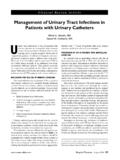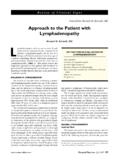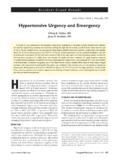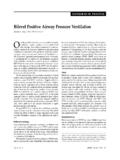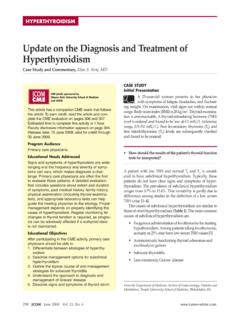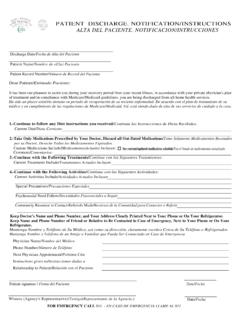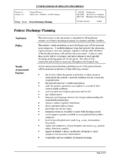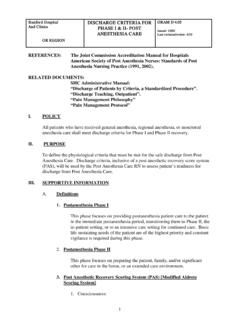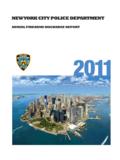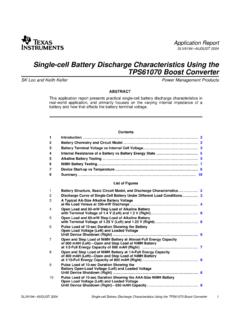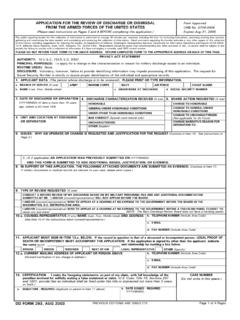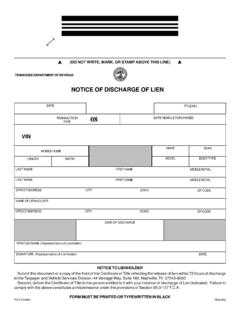Transcription of A 17-Year-Old Boy with Umbilical Discharge
1 CASE PRESENTATIONH istoryA 17 - year - old boy, recently emigrated from Mexico,presented to the pediatric emergency departmentcomplaining of a yellow, foul - smelling Discharge fromthe umbilicus. He noticed the drainage 3 days previ-ously while changing out of his shirt, which had beenstained yellow over the site of drainage. The followingmorning he experienced increasingly sharp, intermit-tent abdominal pain around the site of the Discharge ,which had increased in quantity. The abdominal pain was located only at the site ofdrainage and did not radiate to any other pain, however, was worse when he strained to uri-nate or defecate.
2 As far as the patient recalled, the siteof the drainage was clean and the skin was intact 3 daysprior to presentation. On the evening the patient pre-sented to the emergency room, he admitted that hehad never had this pain or Discharge before, and hedenied any history of periumbilical trauma or abdomi-nal surgery. He also denied dysuria and hematuria butconceded that he had not had a bowel movement in 2 days. The patient reported no associated nausea,vomiting, diarrhea, rash, or fever. A review of systemswas completely PointInflammation in the Umbilical region confers high risk tothe patient if pyogenic bacteria were to spread hema-togenously or extend to the liver or peritoneum.
3 Itmust be worked up as early as ExaminationThe physical examination revealed a well -developed, well - nourished adolescent male with thefollowing vital signs: oral temperature, C ( F);heart rate, 78 bpm; respiratory rate, 15 breaths/min;blood pressure, 120/84 mm Hg. His weight was at the50th percentile and height at the 25th percentile forhis age. The patient did not appear toxic or in acutedistress. He was able to ambulate with minimal discom-fort but preferred lying on his back. Examination ofthe head and neck was unremarkable. Auscultation ofthe chest revealed clear symmetric breath sounds anddistinct S1and S2heart sounds without the presence ofa murmur, rub, or gallop.
4 A thick, yellow, purulent dis-charge was noted pooling around the umbilicus. Nosigns of traumatic injury to the skin were noted, andthere was minimal erythema at the site. He had nor-moactive bowel sounds. He grimaced when the umbili-cal area was palpated, but there was no evidence ofrebound tenderness. No Umbilical fluctuance or lowerquadrant tenderness was noted. The remainder of theexamination was PointThe absence of rebound tenderness or other peri-toneal signs is reassuring that the infection remainslocalized. The vital signs indicate no systemic inflam-matory response, which suggests that the infection iseither very acute or is and Imaging StudiesThe results of the laboratory studies are shown inTable 1.
5 The adolescent was sent for an abdominalcomputed tomography (CT) scan (Figure 1). The scanshowed a midline thick- walled cystic structure 3 cm indiameter, filled with fluid extending toward the upperpelvis but not contiguous with the bladder or bowelwall. Dr. Martin is a resident in pediatrics and Dr. Lembo is an associate pro-fessor of clinical pediatrics and director of medical education, Depart-ment of Pediatrics; both are at New York University School of Medicine,New York, NY. - Physician May 200419 Pediatric RoundsSeries Editors: Angelo P. Giardino, MD, PhD Patrick S. Pasquariello, Jr.
6 , MDA 17-Year-Old Boy with Umbilical DischargeMichael S. Martin, MDRobert M. Lembo, MDKey PointDespite a normal erythrocyte sedimentation rate, amoderately elevated leukocyte count, and the failure ofthe patient to mount a fever, the cystic structure wasclearly infected, as demonstrated by Umbilical pain andpurulent Discharge . Clinical signs in this case weremore informative than the laboratory values. The clini-cal findings can be explained by the walled-off nature ofthe lesion that eventually ruptured, presumably due toincreased pressure within the cavity. What is the differential diagnosis for an adolescentor child with Discharge from the umbilicus?
7 DIFFERENTIAL DIAGNOSISD ischarge at the umbilicus generates a narrow butimportant differential diagnosis. Table 2summarizesthe differential diagnosis by usual age of infectious etiology for this patient s acute pre-sentation is clear considering the presence of pus, butthe more important question is why and what becameinfected. The contents of a Discharge involving theumbilicus may include pus, urine, mucus, and/or fecalmatter, depending on what lies at the end of the com-municating lesion. The presence of feculent, bilious, seropurulent, orserous Discharge at the umbilicus may indicate that theunderlying defect is either an omphalomesenteric(vitelline) duct or an intestinal Umbilical fistula.
8 Anomphalomesenteric duct represents the failure of theembryonic midgut to involute and break contact withthe yolk sac. Such a duct may persist in nearly 2% ofinfants and may take the form of a Meckel diverticu-lum; omphalomesenteric cyst; or an Umbilical fistula,polyp, or cyst. In rare cases, the duct is so large as toallow prolapse of the bowel. A study of 217 childrenwith vitelline duct anomalies demonstrated that ap-proximately 40% of these lesions were symptomatic,and of these, more than 80% were symptomatic withinthe first 2 years of case patient s age alonemakes this diagnosis highly unlikely.
9 In this case, theabdominal CT clearly demonstrated no communica-tion with the bowel, but in cases in which communica-tion with the bowel cannot be ruled out, injection ofcontrast agent into the Umbilical orifice followed byradiography can be highly urine is present in the Discharge , a communica-tion with the bladder is likely. This would be consistentwith a urachal remnant. If this relationship is unclear,contrast radiography can be employed to better definethe lesion. In the case of this patient, pus was clearly expressedfrom the wound. If there had been a communicationwith the bladder, leukocytes, leukocyte esterase, ororganisms would have been present in the patient surine.
10 This was not the case, and the abdominal CT scan20 Hospital PhysicianMay - & Lembo : Pediatric Rounds : pp. 19 25 Table Values of Case PatientNormalVariableResultValuesBlood/s erumLeukocyte count ( 103/mm3) ( )Differential count (%)Neutrophils6540 60 Lymphocytes2320 40 Monocytes102 8 Eosinophils011 4 Platelet count ( 103/mm3)2910150 350 Hemoglobin (g/dL) ( )Erythrocyte sedimentation 08 0 10rate (mm/h) esteraseNegativeNegativeErythrocytesNega tiveNegativeLeukocytesNegativeNegativeFi gure 1. Computed tomographic scan of the case patient atpresentation. A cystic, fluid-filled structure is visible at themidline (arrow).



